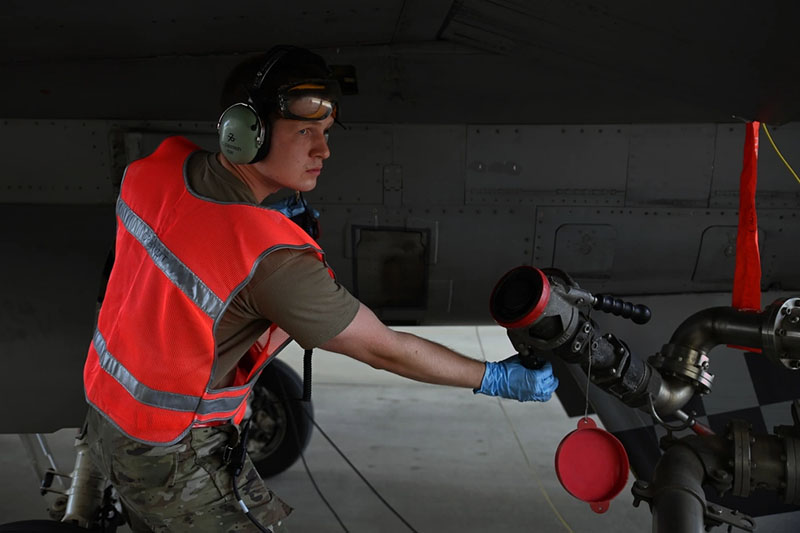


Military entomologist
Photos courtesy of Thor Freeman November 08, 2024
UD insect ecology and conservation student Thor Freeman pursues medical entomology career with the U.S. Air Force
After meeting medical entomologists during his time serving in the United States Air Force, Thor Freeman, now a sophomore at the University of Delaware, became very aware of the risks that pests have on the military. This knowledge inspired him to dive into the history of different vector-borne diseases that have impacted the armed forces in the past.
“A lot of militaries throughout history have been heavily affected by pests,” Freeman said. “For instance, in Napoleon’s army, about a third of the troops died when they entered Russia because of fleas and other insect pests that vector the diseases that cause harm.”
“Same with the bubonic plague — people say the rats caused the bubonic plague and transferred [disease], but that’s not necessarily true,” he continued. “It was the fleas on the rats that were actually hosting that plague that then got onto humans and caused actual death.”

These issues are why the United States government invests in medical entomologists — scientists who can evaluate the role that insects play in the pathogenesis of diseases in humans and animals. This field is vital for maintaining good public health conditions and encompasses medicine, forensic science and public health issues related to insects.
This thirst for knowledge led him to UD’s Department of Entomology and Wildlife Ecology, where he is majoring in insect ecology and conservation with the hopes of becoming a medical entomologist upon graduation.
“Right now, I’m in ROTC, and I was in the Air Force before coming here,” Freeman said. “But I would like to rejoin the Air Force after I graduate as a medical entomologist.”
In preparation for his future career, Freeman is conducting research as a Cooperative Extension Scholar with UD’s Brian Kunkel, entomologist and Cooperative Extension specialist.

Crapemyrtle bark scale
Freeman’s research focused on the crapemyrtle bark scale (CMBS), an ornamental pest that damages crape myrtle trees by creating a sooty mold from insect dropping, also known as honeydew, on the leaves and flower clusters of the plant.
CMBS marches around the plant, searching for the best place to hunker down. Once the insect finds the perfect spot, it buries its mouth parts into the plant and never moves again. CMBS then creates a waxy shell covering its body to protect it from the surrounding environment.
The female CMBS lays her eggs within the protective shell. This technique makes these insects incredibly difficult to control because, for most of their lifetimes, they are protected from the elements with their waxy shell and have very few natural enemies.

The insect’s enduring gift, this sooty mold on the bark from droppings, is a nightmare for retailers trying to sell crape myrtles.
“This sooty mold that they produce — it’s very difficult to get rid of,” Freeman said. “And once it’s on there, you’re going to have to do a lot of work to get off. So, if you’re a nursery owner who has rows and rows and rows of crape myrtles infested by crapemyrtle bark scales, it’s going to be a huge problem for you, as no one's going to buy those plants.”
This is where Kunkel and Freeman come in. They aimed to study the life cycle of CMBS and determine the best time in their life cycle to target them with insecticides.
CMBS are most vulnerable during their crawler stage, right after they emerge from their eggs and search for a place to bury themselves.

“The crawler stage is when you need to find them,” Freeman said. “We’re trying to count the crawlers so we could tell people in Delaware, this is when the crapemyrtle bark scale is active, and this is when you should be spraying.”
This is critical information for both homeowners and nursery owners. If you spray for the crapemyrtle bark scale when they’re hunkered down and covered in wax, they will remain unaffected. Freeman explained that there are no pesticides that can effectively and safely penetrate their shells.
Freeman used double-sided tape to tape around the trunks of crape myrtle trees around UD’s Ecology Woods — a 35-acre parcel of forest on UD’s main campus in Newark that is used for research. Once the CMBS in the crawling stage were stuck on the tape, they would bring the crawlers into the lab and count them under a dissecting microscope.
“It’s a little tedious, but you get a good number of how many crapemyrtle bark scales there are and when they are most active here in Delaware,” Freeman said. “They have two cycles of life, so we’re tracking both of those, and we have them all logged so we could tell people when to spray for them.”

Preparing for the future
In addition to his work with the crapemyrtle bark scale, Freeman also investigated the red-headed flea beetle. These common nursery pests feed on leaves; the beetles create holes and eventually skeletonize the leaves, which can kill the plants. He has also studied the effect that native plants have on the diversity of insects in a plot of plants. His research in these areas helps to inform the public about when to spray for ornamental pests and why native plants are so essential for maintaining a healthy ecosystem.
“Another huge part of medical entomology is integrated pest management, which is what I’ve been doing with [Kunkel],” Freeman said. “So this is a nice way to get myself involved with the field and build my resume for the future.”
Contact Us
Have a UDaily story idea?
Contact us at ocm@udel.edu
Members of the press
Contact us at 302-831-NEWS or visit the Media Relations website

